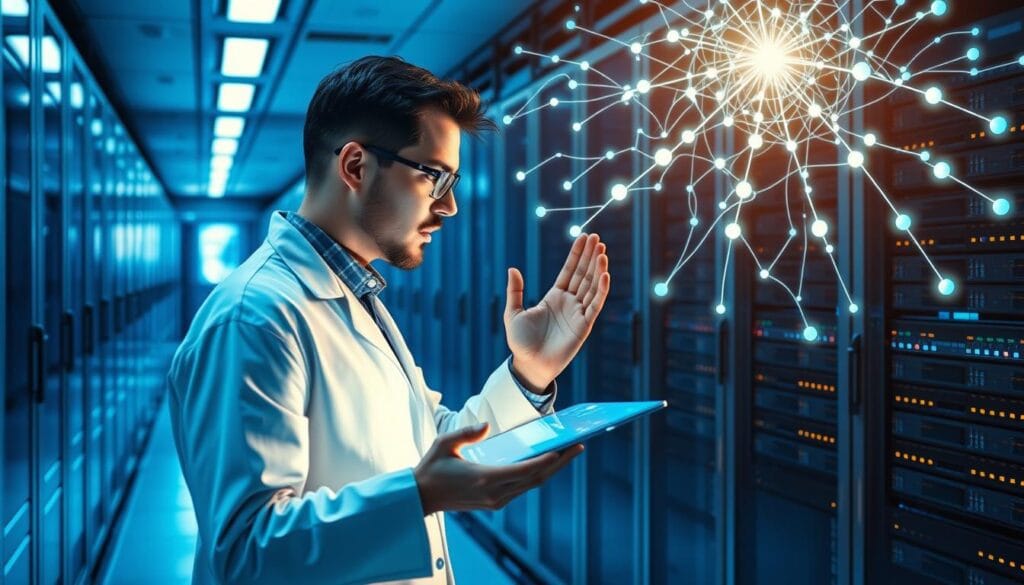Did you know data scientists spend 60-80% of their time on cleaning and preparing data? AI is changing this by making data science more efficient. It’s not just a trend; it’s a big change for many industries and how we make decisions.
AI is taking over many data analysis tasks. Experts say it will replace traditional data analysis in 5 to 10 years. This change shows how important math and statistics skills are in the new data world.
This article will show how AI is changing data science. It’s freeing professionals from boring tasks, so they can find insights quickly. Working together is key as companies focus on AI roles. Teamwork and community are vital for success.
Let’s dive into the science of AI and its impact on data science. We’ll uncover new opportunities for data-driven insights. This future will make insights more accessible than ever.
Key Takeaways
- AI technologies are predicted to take over many data analysis tasks within the next decade.
- Data scientists prioritize high-quality data for improved model accuracy and decision-making.
- Collaboration and community-building are essential for succeeding in the AI-driven data landscape.
- Skills in math and statistics will become more crucial compared to traditional software engineering abilities.
- Automation of data tasks will enable data scientists to focus on higher-order analytical functions.
The Role of AI in Modern Data Science
AI is changing data science in big ways. It makes work more efficient and easier to analyze. By automating simple tasks, data scientists can focus on more important work.
This change is key for businesses to stay ahead. They need to keep up with the market’s fast pace.
AI helps make better decisions by using past data. It offers insights that lead to better analysis. AI also cuts down on mistakes and makes getting data faster.
But, we must not rely too much on AI. It’s important to have humans check the work. This keeps research honest and accurate.
The future will see more work with AI and humans. AI will handle big data, letting us explore new areas. It’s crucial for data experts to keep learning and understand AI’s ethics.
Understanding Artificial Intelligence and Its Applications
Artificial intelligence includes many technologies like machine learning, natural language processing, and robotics. These technologies are changing how we handle data today. Companies using AI can find patterns in big data, leading to better decisions.
AI in data science is a big deal for businesses. It has changed many industries, like finance and logistics. For example, AI has cut fraud in finance by 30%. It has also cut downtime in manufacturing by almost 40%.
Retailers use AI to manage their stock better, reducing waste and boosting sales. Logistics companies that use AI for route planning see their delivery times drop by 15%. This shows AI’s big impact.
AI is also helping in hiring, cutting the time to find the right person by 20%. In healthcare, AI looks at past data to predict patient needs better. This shows AI’s importance in many fields.
For businesses looking to improve and make more money, AI is key. AI systems learn and improve, helping businesses stay ahead. The more companies use AI, the more they gain an edge in the market.

How AI is Changing Data Science
Artificial intelligence is changing data science in big ways. It makes data analysis and processing faster and more accurate. Businesses use AI to quickly sort through huge amounts of data.
This change helps them get insights faster and respond to market changes quicker.
The Impact on Data Analysis Processes
AI is changing how we analyze data. It finds patterns and trends without needing much human help. This means fewer mistakes and less work for people.
AI can handle huge amounts of data, helping companies make quick decisions. Using machine learning, businesses can do more analysis than ever before. This gives them a big advantage over their competitors.
Real-Time Data Processing Improvements
Real-time data processing is key in today’s data science. AI makes it possible for companies to change their operations fast. They can adjust to what customers want right away.
AI also makes customer experiences better. It helps companies work more efficiently and keep up with market demands. This is crucial for staying ahead in the business world.

AI-Driven Innovations in Data Modeling
The world of data modeling is changing fast, thanks to AI. Companies are using machine learning to make better models. These models help predict things and make operations smoother.
One cool thing is synthetic data generation. It lets people make realistic data sets while keeping privacy safe. This method makes analysis more accurate and cuts down on bias.
AI is making a big difference in fields like agriculture. It helps farmers by optimizing planting and harvesting. This way, crops grow better and farming stays green.
AI also looks at drone and satellite pictures to check on crops. This helps farmers guess how much they’ll get from their crops.
In healthcare, AI is a game-changer too. It helps find new medicines by predicting how molecules work together. Deep learning helps doctors spot diseases early, like cancer.
By using AI, companies can find new patterns in data. This leads to smarter models and better decision-making. It’s all about being quick and smart in today’s fast world.

Enhancing Data Quality with AI Technologies
As more companies use artificial intelligence, making sure data is good quality is key. Bad data can lead to wrong results, hurting trust. A strong data governance plan is vital to keep data accurate and in line with rules.
AI is now key in setting data standards and fixing data problems in companies.
Data Governance and AI's Role
Data governance is more important than ever with more and different data around. Companies need clear rules and steps to keep data quality up. AI helps by watching data in real-time and spotting oddities.
AI can quickly tell teams about data changes, like different data structures. For example, AI can check data structures fast, helping to keep quality high.
Addressing Data Integrity Challenges
Fixing data integrity issues often means investing in big data platforms. These platforms help with storage, databases, and fast computing for AI and analytics. Good data quality is crucial for AI to work well.
AI can find odd data points, suggest fixes, and cut down on data error downtime. It can also make data transformation faster, improving efficiency.
Automation in Data Science Workflows
Automation in data science is changing the game for analytics. It cuts down time on simple tasks, letting data scientists focus on new ideas. Companies using these tools get better results and make fewer mistakes.
Smart hiring tech is a big win for automation in data science. It makes hiring faster and fairer. AI tools check if candidates fit the job well, without human bias.
Automation is also a game-changer in healthcare and manufacturing. It helps keep things running smoothly by making smart decisions on its own. For example, it can plan repairs without human help, keeping operations going.
Data scientists are now doing more than just tech work. They need to understand strategy too. Automation is not just a tool; it’s a key to unlocking the future of data-driven industries.
AI's Contribution to Predictive Analytics
AI is changing predictive analytics in many fields. It uses machine learning to better understand past data. This makes forecasts more accurate. Companies use AI to guess market trends, customer actions, and how products will do.
Improving Forecast Accuracy with Machine Learning
Machine learning is changing how industries work. In healthcare, AI helps spot high-risk patients early. This leads to a 30% jump in early care rates.
Hospitals also use AI to guess when patients will arrive. This cuts wait times by 20%. AI helps use resources better and improves patient care.
AI also saves money by cutting down on tests and procedures by 15%. This is a big win for healthcare budgets. By 2025, healthcare will spend over $34 billion on AI, mostly on predictive tools.
70% of healthcare using AI see better patient results. This shows AI’s worth in predictive analysis.
Using AI, companies can handle uncertainty better. Predictive analytics can cut no-show rates by almost half. AI makes operations 40% more efficient in managing resources and staff.
These gains show AI in predictive analytics is more than just tech. It’s a game-changer for industries.
Transformative AI Tools for Data Visualization
AI tools for data visualization are changing how we look at data. They use smart algorithms to turn complex data into easy-to-understand visuals. This makes enhancing data interpretation simpler, helping everyone get the point without getting lost in details.
Studies show that 90% of reports from companies go unused. This makes it hard to make decisions. But, with interactive dashboards, companies can cut down on reports and make communication smoother. AI tools help solve these problems, making teams work better together.
These tools do more than just make data look good. They can handle huge amounts of data fast, cutting down analysis time by 70-85%. This means getting insights quickly, not hours later.
AI tools also let visuals change as data updates in real time. This keeps everyone informed with the latest info. Plus, they help predict future trends, helping companies make smart choices.
| Statistic | Impact |
|---|---|
| 70-85% reduction in time from data to visualization | Faster decision-making |
| 3-5x increase in analytical capacity with existing teams | Higher efficiency in data analysis |
| 40-60% broader data utilization across departments | Enhanced insights across the organization |
| 25-30% improvement in decision-making confidence | Better outcomes from strategic choices |
| 30-40% more actionable insights from the same datasets | Improved business strategies |
Using AI for data visualization can really help businesses. It makes data easier to understand and share. As companies rely more on data, using AI for visuals is key to success.
Conclusion
AI in data science marks a big change in how we analyze data. It’s not just a trend; it’s a key part of today’s and tomorrow’s industries. By using AI, companies find new insights, make processes smoother, and spark new ideas.
Businesses are now automating simple tasks. This lets experts tackle tough problems instead of doing the same thing over and over. AI is making a big difference in fields like science and online shopping. But, it’s important to keep human judgment at the heart of decisions.
As technology gets better, AI’s role will grow even bigger. Keeping data quality high and using AI wisely is crucial. This way, we can unlock all the potential of AI in data science.
FAQ
How is AI transforming data science?
AI is changing data science by making decisions better, automating simple tasks, and offering smarter ways to analyze data. This helps companies use big data more effectively.
What role does AI play in data analysis?
AI is key in making data analysis faster and more accurate. It automates cleaning data, finds trends, and predicts market changes.
How does AI improve predictive analytics?
AI boosts predictive analytics by using machine learning to study past data. This leads to more precise forecasts and insights, helping in making better decisions.
What technologies are included in artificial intelligence?
Artificial intelligence includes many technologies like machine learning, natural language processing, robotics, and data analytics. These all help in modern data practices.
How does data quality impact AI outcomes?
Bad data can ruin AI results, making companies less confident. So, keeping data quality high is crucial for AI to work well.
What benefits does automation bring to data science workflows?
Automation in data science makes workflows more efficient. It frees up data scientists to work on new projects, leading to quicker insights and decisions.
How does AI impact data visualization?
AI-driven data visualization tools create dynamic visuals that update with new data. This makes complex data easier to understand, helping teams get actionable insights.
What future opportunities does AI present in data science?
AI’s integration in data science opens up new growth paths. It uncovers new insights, streamlines operations, and encourages innovation in many industries.
Source Links
- https://www.businessinsider.com/data-science-high-demand-ai-what-to-know-2025-3 – I was a data scientist at NASA. Here are 5 things to know before you enter the field as it evolves with AI.
- https://www.newswise.com/articles/ai-data-science-and-the-transformation-of-scientific-research-a-primer – AI, Data Science, and the Transformation of Scientific Research: A Primer | Newswise
- https://www.linkedin.com/pulse/rise-generative-ai-what-means-data-scientists-walter-shields-4vhwe – The Rise of Generative AI: What It Means for Data Scientists
- https://www.technologynetworks.com/tn/blog/ai-is-redefining-the-role-of-the-scientist-heres-how-397327 – AI Is Redefining the Role of the Scientist – Here’s How
- https://www.softude.com/blog/how-ai-is-changing-data-analytics – 7 Ways AI Is Changing Data Analytics in Business
- https://www.nytimes.com/interactive/2025/03/16/technology/ai-data-centers.html – How A.I. Is Changing the Way the World Builds Computers
- https://www.mckinsey.com/capabilities/quantumblack/our-insights/the-state-of-ai – The state of AI: How organizations are rewiring to capture value
- https://magazine.columbia.edu/article/how-artificial-intelligence-changing-biomedical-research – How Artificial Intelligence Is Changing Biomedical Research
- https://www.ewsolutions.com/ai-and-machine-learning-integration-in-data-management/ – AI and Machine Learning Integration in Data Management
- https://blog.dataiku.com/how-generative-ai-is-transforming-enterprise-data-challenges – How Generative AI Is Transforming Enterprise Data Challenges
- https://www.techtarget.com/searchdatamanagement/opinion/AIs-appetite-for-data-is-changing-data-requirements – AI’s appetite for data is changing data requirements | TechTarget
- https://medium.com/@wyaddow/data-engineers-are-using-ai-to-verify-data-transformations-752928774fc6 – Data Engineers Are Using AI to Verify Data Transformations
- https://www.datasciencecentral.com/are-data-scientists-obsolete-in-the-agentic-era/ – Are data scientists obsolete in the agentic era? – DataScienceCentral.com
- https://www.analyticsinsight.net/data-science/how-data-science-will-change-with-agentic-ai – How Data Science Will Change with Agentic AI?
- https://medium.com/@skphd/the-transformation-of-data-science-in-the-agentic-era-from-manual-analysis-to-autonomous-79b70f38c51f – The Transformation of Data Science in the Agentic Era : From Manual Analysis to Autonomous…
- https://www.keragon.com/blog/ai-predictive-analytics-in-healthcare – AI Predictive Analytics in Healthcare: What Is It & Benefits
- https://www.forbes.com/councils/forbestechcouncil/2025/03/12/the-evolution-of-data-analytics–data-engineering-with-ai-agents/ – The Evolution Of Data Analytics & Data Engineering With AI Agents
- https://medium.com/@odsc/ai-data-science-survey-report-2025-trends-insights-key-findings-27e8313b02d2 – AI & Data Science Survey Report: 2025 Trends & Insights Key Findings
- https://builtin.com/articles/ai-powered-data-visualization – How to Supercharge Your Data Visualization and Reporting With AI | Built In
- https://appwarstechnologies.com/how-ai-and-data-science-are-transforming-industries/ – How AI and Data Science are Transforming Industries
- https://onyxdata.co.uk/ai-data-visualization-bi/ – How AI-Driven Data Visualization is Reshaping Business Intelligence
- https://www.technologynetworks.com/informatics/blog/ai-is-redefining-the-role-of-the-scientist-heres-how-397327 – AI Is Redefining the Role of the Scientist – Here’s How
- https://www.tehrantimes.com/news/510821/The-rise-of-AI-How-data-science-is-powering-the-Fourth-Industrial – The rise of AI: How data science is powering the Fourth Industrial Revolution





